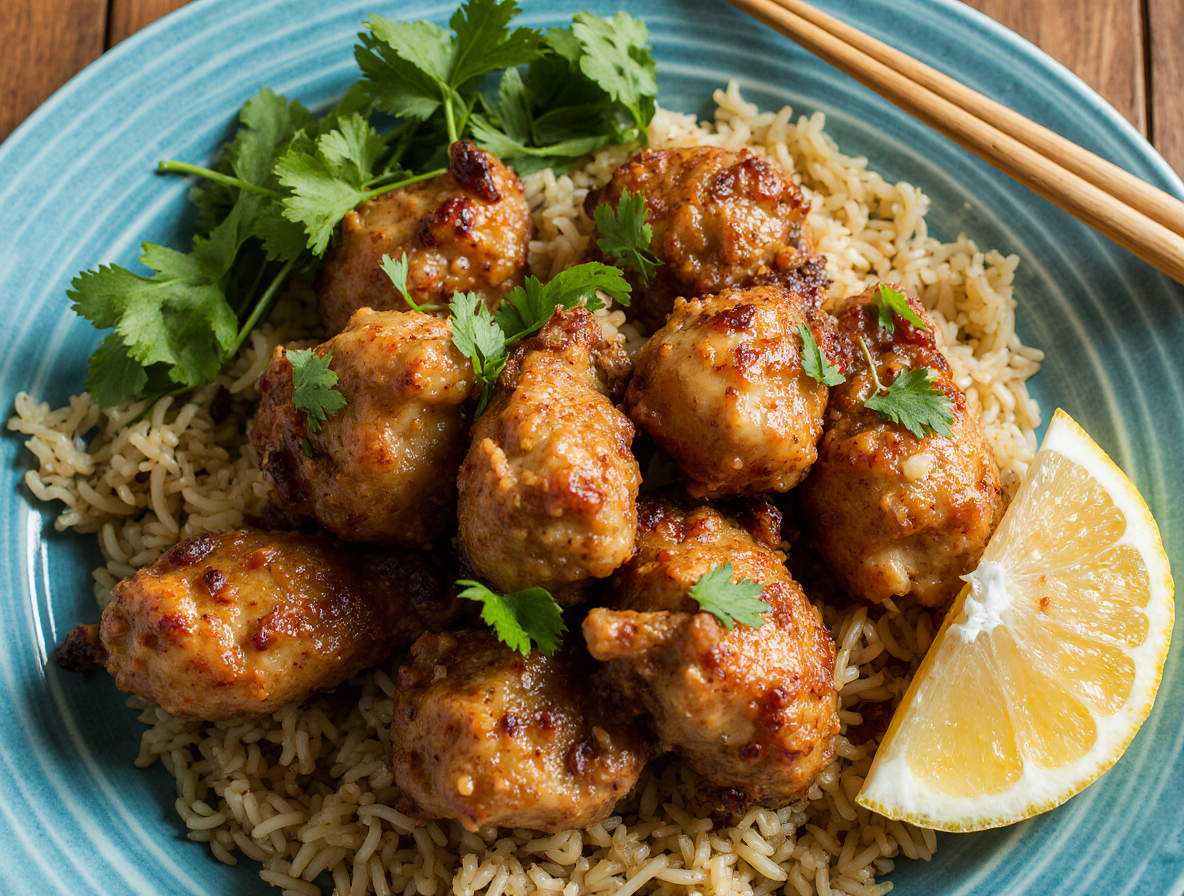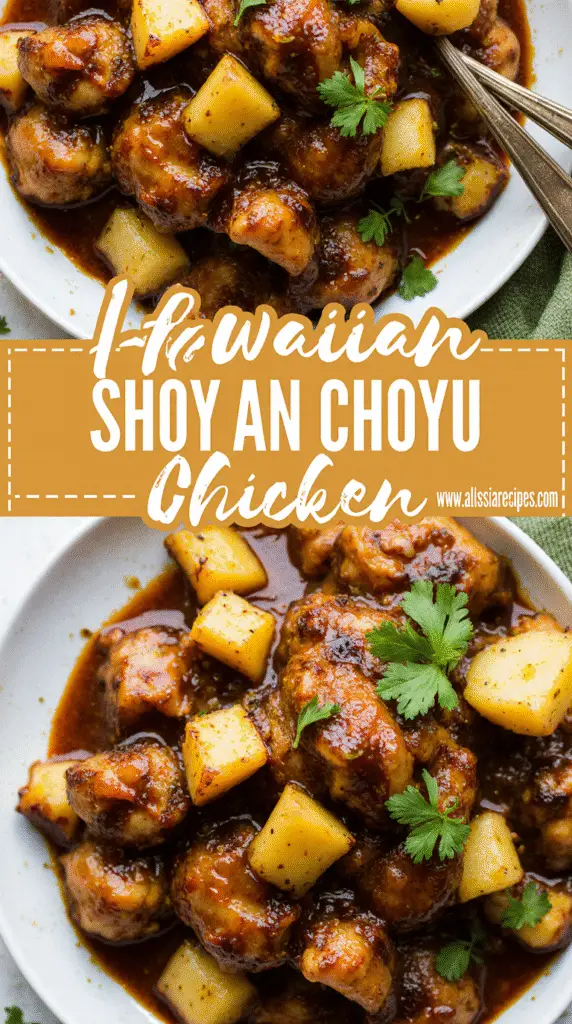How to Make Hawaiian Shoyu Chicken: A Family Recipe That Never Fails
Did you know that an authentic Hawaiian shoyu chicken recipe requires just 6 simple ingredients and less than an hour of your time?
This iconic local Hawaii meal has become one of my all-time favorite comfort foods, and for good reason. Shoyu chicken is wildly popular throughout Hawaii, featuring bone-in, skin-on chicken thighs simmered in a flavorful sauce. What makes this dish truly special is its simplicity – it’s a no-fuss, one-pot wonder that delivers incredible flavor despite its straightforward preparation.
If you’re looking for how to make shoyu chicken that tastes authentic, you’ve come to the right place. This easy Hawaiian shoyu chicken recipe yields tender chicken with approximately 338 calories and an impressive 33g of protein per serving. The best Hawaiian shoyu chicken recipe balances sweet and savory flavors perfectly, using Aloha shoyu (a specific type of soy sauce) that gives the dish its distinctive taste.
In this article, I’ll share my family’s foolproof shoyu chicken Hawaii recipe that has never disappointed. Let’s get cooking!
What Makes Hawaiian Shoyu Chicken Special
Hawaiian shoyu chicken represents the beautiful fusion of flavors that defines local Hawaiian cuisine. This dish tells a compelling story of cultural exchange and culinary evolution across generations.
The roots of shoyu chicken in Hawaii
The origins of Hawaiian shoyu chicken date back to the late 1800s when Japanese immigrants arrived in Hawaii to work on sugarcane and pineapple plantations. These newcomers brought their cooking techniques and traditional ingredients, including shoyu (soy sauce), which blended harmoniously with local Hawaiian flavors. Over time, this multicultural exchange created a unique culinary tradition that became distinctly Hawaiian.
Much like other beloved Hawaiian dishes, shoyu chicken emerged from the melting pot of Chinese, Portuguese, Japanese, Filipino, Korean, and Puerto Rican influences that shaped the islands’ food culture beginning in the 1850s. Initially adapting Japanese soy-braised dishes with local ingredients, Hawaiian cooks eventually developed their own special version that stands as a testament to Hawaii’s rich cultural heritage.
Why it’s a comfort food classic
Throughout the islands, shoyu chicken has become the epitome of comfort food for several compelling reasons. First, it’s incredibly versatile – found everywhere from local plate lunch spots and restaurants to family gatherings and potlucks. Additionally, the dish’s perfect balance of sweet, salty, and umami flavors creates a deeply satisfying eating experience.
The practical aspects of shoyu chicken further cement its status as a beloved classic. As a one-pot meal that feeds many people with minimal fuss, it’s both economical and convenient. Moreover, when paired with steaming white rice and creamy mac salad, it becomes the quintessential Hawaiian comfort plate. Many locals even claim shoyu chicken tastes better the next day, making it perfect for meal planning.
Shoyu vs soy sauce: what’s the difference?
Although often used interchangeably, shoyu and regular soy sauce have distinct differences. Essentially, shoyu is the Japanese term for soy sauce, and it’s the standard terminology in Hawaii. However, Japanese shoyu contains both soybeans and wheat (typically in a 50/50 ratio), whereas traditional Chinese soy sauce often uses soybeans alone.
This wheat addition gives shoyu a milder, slightly sweeter profile compared to the saltier, more aggressive flavor of Chinese soy sauce. Furthermore, shoyu contains just four simple ingredients (soybeans, wheat, salt, and water), while Chinese versions might include up to 12 different components.
In Hawaii, popular shoyu brands include Aloha Shoyu (known for being sweeter and less salty) and Kikkoman (appreciated for its deeper umami flavor).
Essential Ingredients and Substitutions
Creating authentic Hawaiian shoyu chicken begins with selecting the right ingredients. The magic of this dish lies in its simple components, each playing a crucial role in developing that signature island flavor.
Choosing the right chicken cuts
Bone-in, skin-on chicken thighs are undoubtedly the star of any authentic Hawaiian shoyu chicken recipe. This particular cut offers several advantages: the bone adds natural sweetness and complexity to the dish, specifically keeping the meat moist during braising. Meanwhile, the skin contributes additional flavor as its fat slowly melts into the sauce, creating richness that other cuts simply can’t match.
Notably, you can substitute with drumsticks or chicken leg quarters, as they share similar characteristics. Primarily, what matters is keeping both the bone and skin intact. Unless you’re in a real pinch, avoid using breast meat – it tends to dry out quickly and won’t stand up well to the braising process.
Best type of shoyu to use
In Hawaii, soy sauce is commonly called “shoyu,” the Japanese term for this essential ingredient. For the most authentic experience, look for Aloha Shoyu, which locals prefer for its slightly sweeter, less salty profile. Alternatively, Kikkoman (actually a Japanese shoyu) works excellently and is widely available in mainland stores.
First-time makers will be relieved to know that low-sodium varieties of either brand work perfectly in this recipe, certainly helping control the overall saltiness.
Optional add-ins for extra flavor
Beyond the basic ingredients, several additions can elevate your shoyu chicken:
- Aromatics: Fresh ginger and garlic are non-negotiable for authentic flavor
- Sweeteners: Most recipes call for brown sugar, but a honey-brown sugar mix creates deeper flavor while naturally thickening the sauce
- Acids: Rice vinegar adds subtle tanginess; regular white vinegar works as a substitute
- Heat elements: Jalapeño or crushed red pepper flakes offer a gentle kick
- Garnishes: Green onions and toasted sesame seeds finish the dish beautifully
Remember the golden ratio for the base sauce: equal parts shoyu, sugar, and water (or chicken stock) maintain perfect balance.
Step-by-Step: How to Make Shoyu Chicken
Making Hawaiian shoyu chicken requires minimal effort yet yields maximum flavor. The technique transforms simple ingredients into a truly remarkable dish through a few key steps.
1. Prepare the shoyu sauce
Creating the perfect sauce starts with combining shoyu, brown sugar, and water in equal parts. Whisk these together until the sugar completely dissolves. Next, add sliced ginger, chopped garlic, and green onions. For extra depth, consider tasting and adjusting the sweetness or saltiness at this stage. Alternatively, prepare this mixture up to three days ahead and use it to marinate your chicken thighs for even more flavor penetration.
2. Brown the chicken (optional but flavorful)
Though not strictly necessary, browning adds significant depth. Begin with skin side down in a Dutch oven over medium-high heat until the skin turns golden. This step contains splatter better than shallow pans. After browning one side for about five minutes, flip and briefly brown the other. Remember, the chicken doesn’t need to be fully cooked yet.
3. Simmer low and slow
Pour your shoyu mixture over the chicken, ensuring the pieces are mostly submerged. Bring to a gentle boil, then immediately reduce heat to low. Cover and simmer for 30-45 minutes, depending on your chicken size. This low, slow approach makes the meat wonderfully tender and fall-apart delicious.
4. Optional: Broil for crispy skin
For fantastic texture, preheat your broiler on high. Transfer chicken pieces to a foil-lined baking sheet, skin side up. Position the rack about 6-7 inches below the heat source. Broil for 4-5 minutes, watching carefully to prevent burning. This step creates gloriously crispy, caramelized skin.
5. Thicken the sauce (if desired)
As the chicken broils, simultaneously increase the heat under your sauce to high. Let it boil for 5-10 minutes until reduced to your preferred consistency. For quicker thickening, create a cornstarch slurry by mixing cornstarch with hot shoyu broth before adding it back to the sauce. Serve your Hawaiian shoyu chicken immediately, spooning the thickened sauce over the top.
Alternate Cooking Methods and Serving Ideas
Beyond traditional stovetop preparation, this Hawaiian shoyu chicken recipe shines in modern cooking appliances, offering flexibility for busy schedules.
Slow cooker and Instant Pot instructions
For slow cooker convenience, simply combine all ingredients and cook on HIGH for 3-4 hours or LOW for 6-7 hours until the chicken becomes tender. Using frozen chicken? Adjust timing to HIGH for 5 hours or LOW for 8 hours.
In contrast, the Instant Pot delivers remarkably quick results. Add all sauce ingredients with the chicken, seal properly, and cook on high pressure for just 8-10 minutes. Subsequently, allow natural pressure release for 10 minutes before quick-releasing the remaining pressure. For thicker sauce, whisk cornstarch with cold water and stir into the pot during the final cooking phase.
How to serve it plate lunch-style
In Hawaii, shoyu chicken is traditionally served plate lunch-style. This iconic presentation includes two scoops of white rice alongside the classic Hawaiian mac salad. Together with the chicken, these components create the quintessential island meal experience.
Pairing ideas: rice, mac salad, and veggies
Steamed white rice naturally complements shoyu chicken – long-grain varieties remain fluffy whereas short-grain options offer slight stickiness. The beloved Hawaiian mac salad typically combines macaroni, carrots, celery, onions, and a creamy dressing. For added nutrition, consider serving alongside:
- Stir-fried bok choy or kailan
- Sautéed vegetables
- Fresh green salad
Conclusion
Hawaiian shoyu chicken stands as a testament to the beautiful cultural fusion that defines Hawaiian cuisine. Throughout this article, we’ve explored not just a recipe, but also the rich heritage behind this beloved dish. After all, the magic of shoyu chicken lies in its perfect balance of simplicity and flavor—requiring just a handful of ingredients yet delivering incredible taste.
The key undoubtedly remains in selecting the right components—bone-in, skin-on chicken thighs, authentic shoyu, and the perfect balance of sweetness and savory elements. Additionally, the cooking method matters significantly, whether you choose the traditional stovetop approach, convenient slow cooker, or quick Instant Pot technique.
My family has enjoyed this recipe for generations, and I can personally attest that once you master this dish, it will become a staple in your household too. The versatility of shoyu chicken makes it perfect for weeknight dinners, special gatherings, or meal prep for busy weeks ahead.
Regardless of how you choose to serve it—whether plate-lunch style with two scoops of rice and mac salad or alongside fresh vegetables for a more balanced meal—this Hawaiian classic never disappoints. Finally, remember that many locals believe shoyu chicken actually tastes better the next day, so don’t hesitate to make a large batch!
Now that you have this foolproof recipe in your arsenal, you’re ready to bring a taste of Hawaii into your kitchen. This shoyu chicken recipe truly captures the essence of island comfort food—simple, satisfying, and absolutely delicious.
FAQs
Q1. What makes Hawaiian Shoyu Chicken unique? Hawaiian Shoyu Chicken is a fusion dish that combines Japanese cooking techniques with local Hawaiian flavors. It features bone-in, skin-on chicken thighs simmered in a flavorful sauce made with shoyu (Japanese soy sauce), creating a perfect balance of sweet and savory tastes.
Q2. How long does it take to cook Shoyu Chicken? Typically, Shoyu Chicken takes about 30-45 minutes to simmer on the stovetop. However, cooking times may vary depending on the method used. Slow cooker versions can take 3-4 hours on high or 6-7 hours on low, while an Instant Pot can cook the dish in just 8-10 minutes under pressure.
Q3. What’s the difference between shoyu and regular soy sauce? Shoyu is the Japanese term for soy sauce and is commonly used in Hawaii. It contains both soybeans and wheat, giving it a milder, slightly sweeter profile compared to traditional Chinese soy sauce, which is often made with soybeans alone and has a saltier, more aggressive flavor.
Q4. What are the essential ingredients for Shoyu Chicken? The key ingredients for Shoyu Chicken are bone-in, skin-on chicken thighs, shoyu (preferably Aloha Shoyu or Kikkoman), brown sugar, water, and aromatics like ginger and garlic. Optional add-ins can include rice vinegar for tanginess or chili flakes for heat.
Q5. How is Shoyu Chicken traditionally served in Hawaii? In Hawaii, Shoyu Chicken is typically served plate lunch-style. This presentation includes the chicken alongside two scoops of white rice and classic Hawaiian mac salad. For added nutrition, it can also be paired with stir-fried vegetables or a fresh green salad.


